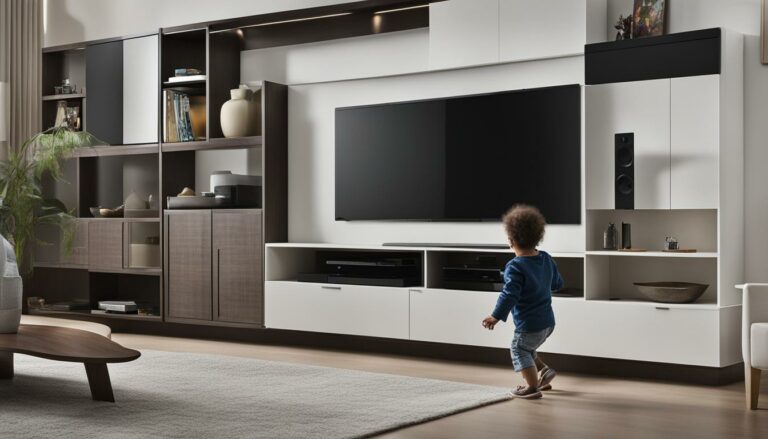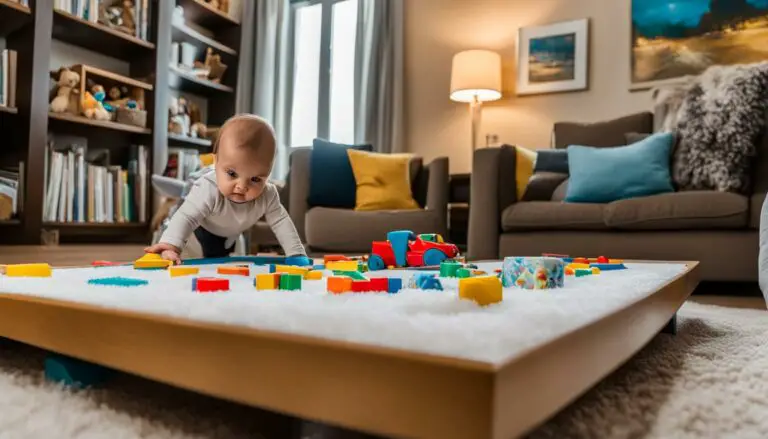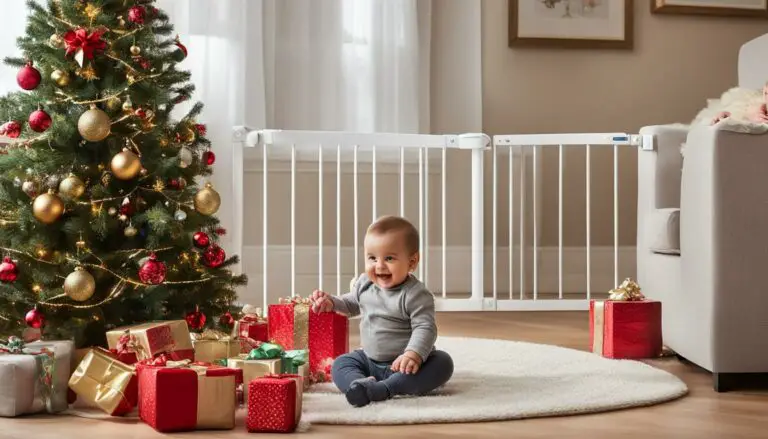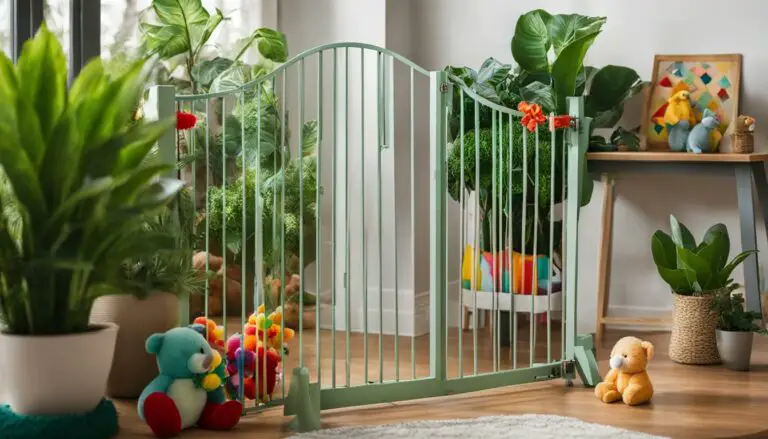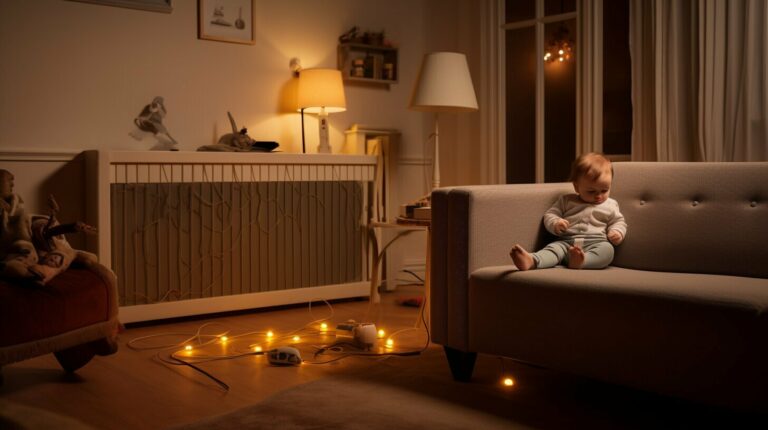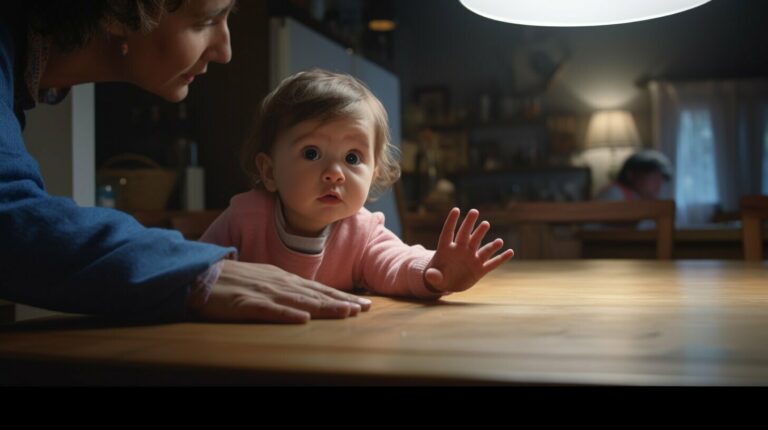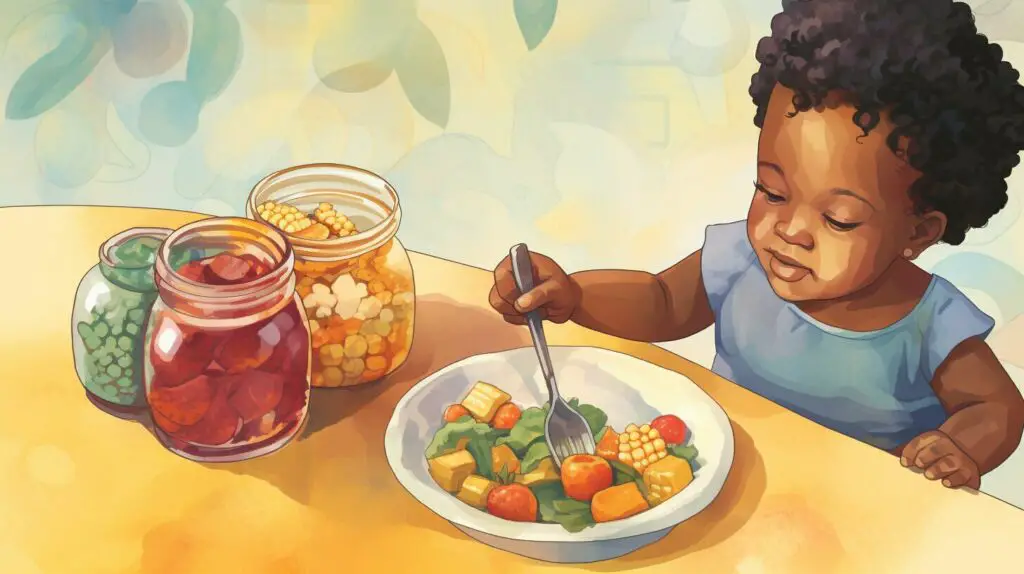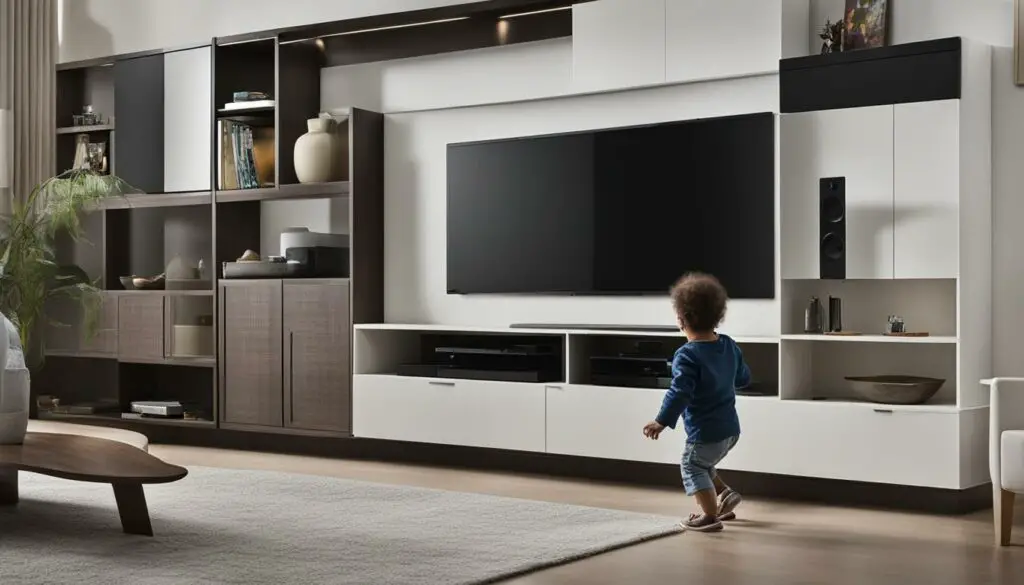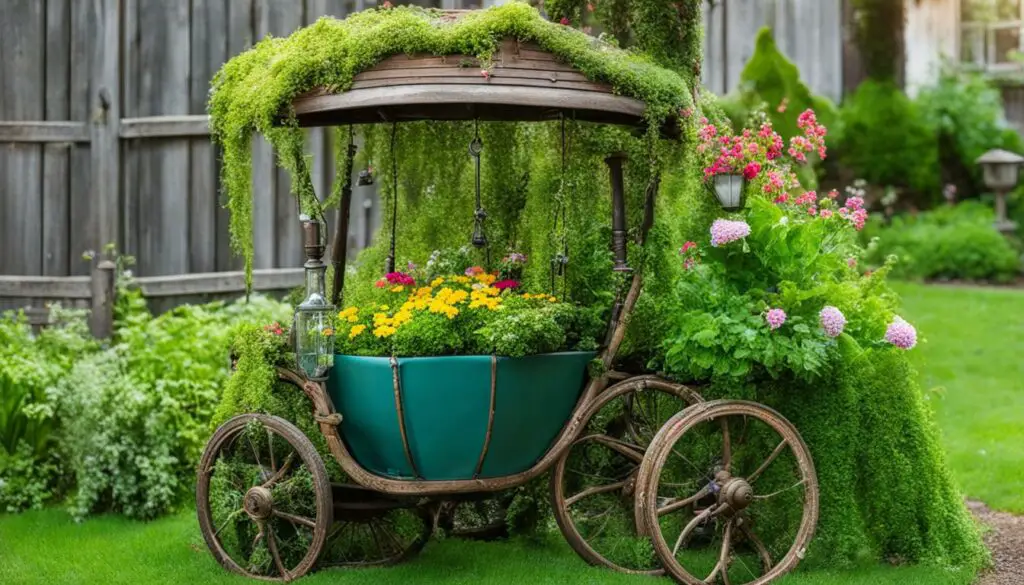As a parent, your top priority is the safety of your child. One of the most important steps you can take to create a safe environment is to babyproof your cabinets. This is especially crucial because young children are curious and prone to accidents. By using locks without handles, you can add an extra level of security and peace of mind.

Key Takeaways:
- Babyproofing your cabinets is essential for creating a safe environment for your child.
- Locks without handles offer an additional level of security.
- There are various types of locks available, including adhesive locks, magnetic locks, and sliding locks.
- Proper installation is key to maximizing the effectiveness of locks.
- Alternatives to locks include childproof latches, elastic bands, and relocating hazardous items.
- Additional safety measures include securing electrical hazards, removing choking hazards, and using corner guards and drawer stoppers.
- Investing in babyproofing cabinets is a small price to pay for your child’s safety.
Different Types of Locks for Babyproofing Cabinets
When it comes to babyproofing cabinets, there are several types of locks that can help keep your little one safe. Each lock offers different benefits and levels of security, so it’s important to choose the right one for your specific needs.
| Type of Lock | Description | Benefits |
|---|---|---|
| Adhesive locks | These locks attach to the outside of the cabinet with strong adhesive. | Easy to install and remove, affordable, no drilling required. |
| Magnetic locks | These locks use a magnetic key to unlock and lock the cabinet. | Not visible from the outside, secure, good for older children who may figure out simpler locks. |
| Sliding locks | These locks attach to the inside of the cabinet and slide back and forth to lock and unlock. | Very secure, hidden from view, work well for cabinets with double doors or knobs. |
Before purchasing any locks, consider the layout of your cabinets and the level of difficulty your child may have in bypassing the lock.
Installing and Removing Babyproofing Cabinet Locks
Installing babyproofing cabinet locks can be a simple process, but it varies depending on the type of lock you choose. Generally, adhesive locks are the easiest to install since no tools or drilling are required. Magnetic and sliding locks may require a bit more effort and drilling.
To install adhesive locks, clean the surface of the cabinet door where the lock will be attached, and then stick the lock in place. For magnetic locks, you will need to drill a small hole in the door and the frame to attach the lock. For sliding locks, you will need to screw the lock to the inside of the cabinet door.
Removing cabinet locks is generally easy and non-invasive as well. Adhesive locks can be carefully pried off, while magnetic locks require removing the catch from the cabinet door. Sliding locks can be unscrewed and removed.
Effectiveness of Babyproofing Cabinet Locks
Babyproofing cabinet locks have proven to be very effective in preventing accidents and keeping little ones safe. Studies have shown that children who live in homes with properly installed and used cabinet locks have a much lower risk of unintentional injuries.
It’s important to note that locks without handles provide an extra layer of security since they are less visible and more difficult for children to figure out.
Cost of Babyproofing Cabinet Locks
The cost of babyproofing cabinet locks varies depending on the type of lock and the quantity needed. You can expect to pay anywhere from $2 for an adhesive lock to $20 for a set of magnetic locks. While it may seem like an added expense, investing in good quality cabinet locks is a small price to pay for your child’s safety.
Alternatives to Using Locks for Babyproofing Cabinets
If you prefer not to use locks, there are alternative methods to babyproofing your cabinets. You can install childproof latches, which prevent the cabinet door from opening more than a few inches. You can also use elastic bands to keep cabinet doors shut, or move hazardous items to higher shelves. Keep in mind, however, that these options may not be as secure as locks and may require more effort to use.
Additional Safety Measures for Babyproofing Cabinets
In addition to locks, there are other safety devices you can use to babyproof your cabinets. Corner guards can be used to protect little ones from sharp corners, while drawer stoppers can prevent drawers from being pulled all the way out. Always remember to keep chemicals and cleaning supplies out of reach, secure electrical hazards, and remove small choking hazards from your cabinets.
Installing and Removing Babyproofing Cabinet Locks
Now that you’ve decided to babyproof your cabinets, it’s time to install locks to keep your little one safe. Before you begin, determine which type of lock is right for your cabinets.
| Type of Lock | Description | Benefits |
|---|---|---|
| Adhesive Locks | These locks attach to the inside of the cabinet door and require a magnetic key to open them. | Easy to install and affordable. |
| Magnetic Locks | These locks are installed inside the cabinet and use magnets to keep the doors closed until released by a magnetic key. | More secure and discreet than adhesive locks. |
| Sliding Locks | These locks fit over cabinet knobs or handles and prevent them from being turned. | Easy to install and remove, with no damage to cabinets. |
Once you’ve chosen the right lock, follow these steps to install it:
- Measure the distance between the lock and the cabinet’s edge to ensure proper alignment.
- Clean the area where the lock will be placed to ensure a secure bond.
- Peel off the adhesive backing and press the lock firmly into place.
- Wait for the adhesive to dry completely before testing the lock.
To remove the lock, follow these steps:
- Gently heat the adhesive with a hair dryer to soften it.
- Carefully peel the lock away from the cabinet.
- Use adhesive remover to clean any residue left behind.
While babyproofing cabinet locks are highly effective in preventing access to cabinets, it’s important to ensure proper installation for maximum effectiveness. Always test locks periodically to ensure they are still working correctly.
The cost of babyproofing cabinet locks varies depending on the type, brand, and quantity needed. Adhesive locks are the most affordable, with prices ranging from $5 to $15 per lock. Magnetic locks and sliding locks can cost up to $50 per lock. While the cost may seem high, investing in locks is a small price to pay for your child’s safety.
If you prefer not to use locks, there are alternative methods of babyproofing cabinets, such as installing childproof latches, using elastic bands, or relocating hazardous items to higher shelves. However, locks without handles provide an additional layer of protection and are highly recommended.
Effectiveness of Babyproofing Cabinet Locks
Babyproofing cabinet locks are an essential part of creating a safe environment for your little ones. Studies have shown that accidents involving children and cabinets can occur quickly and unexpectedly. Locks provide an excellent preventive measure by stopping toddlers from accessing potentially hazardous items such as chemicals, sharp objects, or medicines.
There are various types of locks available to suit different lifestyles and needs. Adhesive locks are easy to install and remove, magnetic locks offer a secure option that is out of sight, and sliding locks are more durable and suitable for heavy-duty use.
Installing babyproofing cabinet locks is a straightforward process that requires a few simple steps. Generally, adhesive locks attach directly to the cabinet without any tools, while magnetic and sliding locks require mounting with screws or adhesive. Removing locks is equally easy and should not damage the cabinet surface.
The effectiveness of babyproofing cabinet locks is undeniable. They are proven to reduce the risk of accidents and injuries associated with cabinet access. According to the National Safety Council, accidental poisoning is one of the leading causes of death in children, most of which are caused by toxic substances found in cabinets. Locks without handles offer an additional layer of protection, making it almost impossible for young children to open the cabinets.
The cost of babyproofing cabinet locks varies depending on the type of lock, brand, and quantity. Adhesive locks are generally the most affordable, ranging between $5 to $20 per pack. Magnetic and sliding locks can be a bit more expensive, costing between $10 and $30 per lock. Investing in locks is a small price to pay for peace of mind and the safety of your child.
If you prefer not to use locks to babyproof your cabinets, there are alternative methods available. Childproof latches, elastic bands, and relocating hazardous items to high shelves are just a few options. However, it’s essential to note that these alternatives may not provide the same level of security as locks.
In conclusion, babyproofing cabinet locks are a must-have for parents with toddlers and young children. The effectiveness of locks in preventing access to cabinets is backed by studies and statistics, making it an essential safety measure. With various lock types available, easy installation and removal, and a range of affordable options, there’s no reason not to secure your cabinets today for a worry-free environment.
Cost of Babyproofing Cabinet Locks
Investing in babyproofing cabinet locks is a small price to pay for your child’s safety. The cost of locks can vary depending on the type of lock, brand, and quantity needed. It’s important to consider the effectiveness and durability of the locks when choosing which one to purchase.
Adhesive locks are typically the most affordable option, costing between $5 to $20 per set. Magnetic locks and sliding locks are mid-range options, ranging from $15 to $40 per set. For the highest level of security, some parents opt for locks with keys which can cost upwards of $50.
While it may seem like a significant expense, the peace of mind that comes with knowing your child is safe is priceless. Remember, it only takes one accident to realize the importance of babyproofing your cabinets.
Alternatives to Using Locks for Babyproofing Cabinets
If you prefer not to use locks to babyproof your cabinets, there are alternative methods to consider.
Childproof Latches
Childproof latches are adhesive or screw-on devices that secure cabinet doors shut. They typically require pressing a button or sliding a latch to release the lock and open the door. Childproof latches are affordable and easy to install, but may not be as secure as locks without handles.
Elastic Bands
Another option is using elastic bands to keep cabinet doors closed. Simply wrap an elastic band around the knobs or handles to prevent them from being opened. Elastic bands are a low-cost option, but may not be as effective as other methods, and could pose a choking hazard if not used properly.
Relocating Hazardous Items
Consider moving hazardous items such as cleaning supplies, medications, and sharp objects to higher shelves or cabinets that are out of reach. This method is effective in preventing access to hazardous items, but may require rearranging your kitchen cabinets and could be inconvenient for daily use.
Corner and Drawer Guards
Corner guards and drawer stoppers are safety devices that prevent children from getting hurt on sharp corners or from pinching their fingers in drawers. While these devices do not secure cabinets, they are an additional safety measure to consider in babyproofing your home.
Remember, while locks without handles are the most secure method for babyproofing your cabinets, there are alternative solutions available if you prefer not to use them. Consider your options and choose the method that works best for your family.
Additional Safety Measures for Babyproofing Cabinets
Besides using locks, there are other safety devices and prevention methods you can utilize to babyproof your cabinets and create a secure environment for your little one. Here are some additional measures you can take:
Safety Devices
Corner guards: These are specially designed cushions that cover sharp edges and corners of cabinets, protecting your child from injuries caused by bumps and falls.
Drawer stoppers: These devices prevent toddlers from pulling out drawers all the way, ensuring their safety by stopping the drawer from becoming a hazard.
Prevention
Aside from safety devices, there are other prevention methods you can implement:
- Store hazardous items such as cleaning supplies or chemicals in high cabinets that your child can’t reach.
- Secure electrical hazards such as power outlets, wires, and appliances with safety plugs or covers.
- Remove small choking hazards such as coins or buttons that may be present in cabinets or drawers.
These safety measures are an excellent complement to the use of locks and can help to ensure maximum safety for your child.
You may also like to read:
Essential Guide to Baby Proofing Your Entertainment Center
Easy Guide to Baby Proofing Without Screws – Safe & Simple!
Baby Proofing Christmas Tree: A Guide for Safe Holidays
Baby Proofing House Plants: A Safe Home for Your Little One
Smart Guide to Babyproofing Cords in Your Home Safely
Essential Guide to Baby Proofing Corners – Keep Your Child Safe
Babyproofing Cabinets: A Must for Toddlers and Children
As your child grows and becomes more curious about the world around them, it’s important to take steps to ensure their safety. One of the most crucial areas to babyproof in your home is your cabinets, where hazardous items such as cleaning supplies and sharp objects are often stored.
Toddlers and young children are especially susceptible to accidents, making it essential to secure your cabinets with proper locks. There are several types of locks available to choose from, including adhesive locks, magnetic locks, and sliding locks. Ensure that you choose the appropriate type of lock depending on the cabinets you need to secure.
Installing and removing these locks is a simple process that requires minimal tools. Most locks come with step-by-step instructions to follow. It’s important to ensure that the locks are properly installed and functioning effectively to prevent accidents.
Studies show that babyproofing cabinet locks can significantly reduce accidents and injuries in young children. Opting for locks without handles adds an extra layer of protection, making it even more challenging for little hands to access dangerous items.
The cost of babyproofing cabinet locks varies depending on the type of lock, brand, and quantity needed. However, investing in locks is a small price to pay for your child’s safety.
For those who prefer not to use locks or may not have access to them, several alternative options are available. You could install childproof latches, use elastic bands, or relocate hazardous items to higher shelves. However, it’s important to note that these alternatives may not be as effective as using locks.
Aside from using locks, additional safety measures to babyproof cabinets include keeping chemicals and cleaning supplies out of reach, securing electrical hazards, and removing small choking hazards. Safety devices such as corner guards and drawer stoppers can also be used to add extra protection.
In conclusion, babyproofing cabinets is a vital step in creating a safe environment for your child. Choose the appropriate type of lock, install and remove them correctly, and opt for additional safety measures when necessary. By taking these measures, you can enjoy peace of mind and prevent accidents and injuries in your little ones.
Conclusion
Babyproofing cabinets is a crucial step to creating a safe environment for your child. By using locks without handles, you can ensure that potentially dangerous items are out of reach.
There are several types of locks available, including adhesive locks, magnetic locks, and sliding locks. Installing and removing these locks is a straightforward process, and proper installation is essential for maximum effectiveness.
Studies and statistics support the use of locks in reducing accidents or injuries, making them a worthwhile investment. The cost of babyproofing cabinet locks varies depending on the type of lock, brand, and quantity needed, but it’s a small price to pay for your child’s safety.
If using locks isn’t your preferred method, there are alternative options such as childproof latches, elastic bands, and relocating hazardous items. However, it’s essential to keep in mind the pros and cons of each alternative and ensure that they’re just as effective.
Additional safety measures that can be taken to babyproof cabinets include keeping chemicals and cleaning supplies out of reach, securing electrical hazards, and removing small choking hazards. Using safety devices like corner guards and drawer stoppers can also add an extra layer of protection.
Remember, babyproofing cabinets is a must for toddlers and young children who are curious and prone to accidents. Take immediate action to secure your cabinets and create a worry-free space for your little one.

